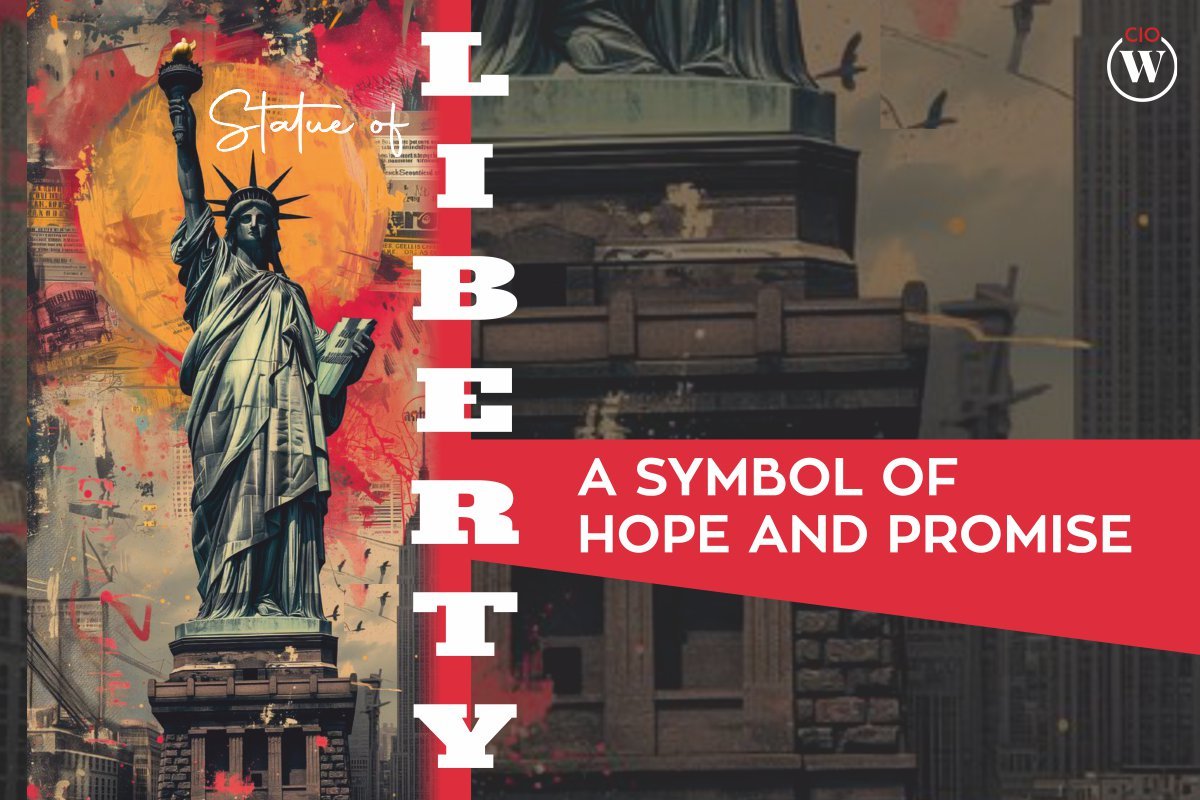Did you know the Statue of Liberty is modeled on its artist’s mother, Augusta Charlotte Bartholdi? This iconic monument stands proudly in New York Harbor, symbolizing the bond between France and the United States, representing freedom and democracy worldwide. With a crown adorned with seven rays, it welcomes immigrants and visitors with open arms that define the core values and ideals of the United States.
Join us on a journey where we will learn about the fascinating history of the statue, its architecture, some of its interesting facts, and a brief guide on how to explore it.
Fascinating History of the Statue of Liberty
In 1865, a prominent political thinker Frenchman Édouard de Laboulaye proposed the idea of presenting a monumental gift from the people of France to the people of the United States. Laboulaye wanted to celebrate the hundredth independence of America as a close relationship between France and America. This idea became even more important and gained traction following the abolition of slavery in the US.
Sculptor Frédéric-Auguste Bartholdi enthusiastically supported the vision of Laboulaye’s vision. His design for the Statue of Liberty, officially titled “Liberty Enlightening the World” was rich with symbolism. He added things to the statue carrying multiple significances: The statue’s crown, adorned with spikes representing rays of light, symbolizes enlightenment spreading worldwide. The tablet in the hands is inscribed with the date of American Independence, July 4, 1776, emphasizing independence and liberty. Shackles and chains in the feet symbolize the abolition of slavery and the pursuit of freedom for all people.

The construction of the Statue of Liberty was completed in France in July 1884. The statue continues to stand as a universal symbol of hope and welcome, inspiring millions with its message of liberty and the pursuit of happiness.
Architecture
The head and arm of the Statue of Liberty were the first sections to be completed. Initially, Viollet-le-Duc helped with the engineering and suggested using a stone pier to support the statue. Unfortunately, he died in 1879, leaving no indication of how he intended to connect the copper skin of the figure to the stone support.
Luckily, in 1880, Bartholdi obtained the services of innovative architect and metal engineer Gustave Eiffel – and his structural engineer Maurice Koechlin. They decided to abandon the pier and instead rely on a metallic skeleton to form the interior framework. The skeleton was made of brass plaques soldered and riveted with the outer copper skin. A thin layer of asbestos with shellac was placed between the layers to prevent the effect of wind or temperature change.
The main parts of the statue were first put together at the Eiffel’s workshop near Paris, then taken apart and shipped to America. The completed statue was given to United States Ambassador Mortan in Paris on July 4, 1884. One year later, in 1885 it was shipped to the United States.
Significance of Parts of the Statue of Liberty
1. The Torch:
The statue’s torch is a combination of copper and gold leaf, held up high in the right hand of a lady. During the daytime, the sun’s ray reflects it in gold, while floodlights illuminate the torch at night. What you see today is not the original torch. The original torch sits in the lobby of the museum. Symbolically, the torch represents enlightenment, meant to guide us toward the path of liberty and justice. Sometimes it also acts as a literal guide, lighting the way for sailors coming to New York Harbor.
2. The Crown:
It is not the crown you imagine on the head of a king or a queen, but rather a series of windows and rays jutting out from the top. They radiate forward like the sun – producing seven colors that represent both the seven continents and seven seas of the world. This is best seen at night when the statue’s crown shines from within.
3. The Tablet:
While the right hand holds the torch, the left hand sits by her side, holding a slab of copper over 23 feet long. The slab is actually a tablet inscribed with the date of independence of the United States in Roman Numerals. Bartholdi chose this date due to its association with America’s Declaration of Independence.
4. The Broken Chains:
Lady Liberty’s feet are surrounded by a broken shackle and chains. It shows her as a goddess, free from oppression and slavery. Chains are half hidden by her robes and nearly impossible to see from the ground for visitors.
5. The Poem:
It is a sonnet named “The New Colossus” written by American poet Emma Lazarus. She wrote it in 1883 to raise money for the construction of the Pedestal for the Statue of Liberty. After its construction in 1903, the text of the sonnet was inscribed on a bronze tablet and placed inside the pedestal.

8 Interesting Facts About the Statue of Liberty
- Its height from the base of the pedestal foundation to the torch is 305 feet, 6 inches. And if considered from her heel to her head, it is about 111 feet, 6 inches.
- The Statue of Liberty weighed around 225 tons.
- UNESCO declared the Statue of Liberty a World Heritage Site in 1984.
- The entire statue was built in Paris between 1881 and 1884.
- The statue was divided into 350 pieces and packed in 214 craters. When the pieces reached America, it took 4 months to assemble these parts.
- In 1986, the torch in the hands of the lady statue was carefully covered with a thin sheet of 24k Gold.
- French and the American people collected $250,000 U.S. Dollars to construct the Statue of Liberty.
- The entire statue is coated in a thin layer of copper, made of cast iron and stainless steel. This copper has slowly aged over time, changing from the reddish-brown hue to the distinctive pale green patination that we know and love today.
Tips for Travelers
Traveling to the Statue of Liberty is one of the most memorable experiences in New York City. Here, I will share some of the most valuable tips – from dressing to where you should go. By the end, you will be an expert on visiting the statue.

1. It is always good to leave for the destination as early as possible:
Throughout the day, the lines for the statue get longer and longer. If you’re able to, it’s always good to catch the first ferry of the day to have a smooth visit.
2. Buy your tickets in advance:
Buying your Statue of Liberty tickets in advance is always a better option. This eliminates the possibility of any extra waiting that you might have while buying tickets and ensures that you get to see everything you want. The easiest way to buy tickets in advance is online. You can typically do it a few months before your scheduled visit. In many cases, you don’t even need to carry prints, simply show tickets in your phone and walk right up to security.
3. Stand on the best side of the boat:
Standing on the right side of the boat gives you the best look at each turn. Most people won’t realize that this is where you will get a better view. As the boat crosses in front of the statue for the first time, you will have the perfect spot for an epic picture of the Statue.
4. Go to the Museum first:
After getting off the boat, the very first thing people do is to take a picture of the statue. This leaves them battling with crowds and competing for the best shots. But if you take time to visit the museum first, you can head over to the statue and avoid the initial wave of the newcomers.
5. Get in line 10 minutes before boat departure:
There is limited capacity in each boat. When the boat fills up, they will stop the lines and there is a chance you could get cut off. You can avoid this just by reaching there with plenty of time before.
Conclusion
The Statue of Liberty symbolizes freedom and friendship between France and the United States. Despite many challenges – financial hurdles and engineering, both nations worked together to create this iconic monument. Located in New York Harbor, it welcomes millions of immigrants and visitors, representing hope and promise for a better life. Plan your next trip to this amazing destination. To discover more fascinating monuments, keep visiting www.ciowomenmagazine.com.









